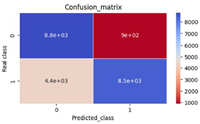A novel decision-making approach based on interval-valued T-spherical fuzzy information with applications
Abstract
Multi-attribute group decision-making (MAGDM) is a very significant technique for selecting an alternative from the provided list. But the major problem is dealing with the information fusion during the information. Aczel-Alsina t-norm (AATN) and Aczel-Alsina t-conorm (AATCN) are the most generalized and flexible t-norm (TN) and t-conorm (TCN), which are used for information processing. Moreover, the interval-valued T-spherical fuzzy set (IVTSFS) is the latest framework to cover the maximum information from the real-life scenarios. Hence, the major contribution of this paper is to deal with the information during the MAGDM process by introducing new aggregation operators (AOs). Consequently, the interval-valued T-spherical fuzzy (IVTSF), Aczel-Alsina weighted averaging (IVTSFAAWA), IVTSF Aczel-Alsina (IVTSFAA) ordered weighted averaging (IVTSFAAOWA), IVTSFAA weighted geometric (IVTSFAAWG), IVTSFAA ordered weighted geometric (IVTSFAAOWG), and IVTSFAA hybrid weighted geometric (IVTSFAAHWG) operators are developed. It is shown that the proposed operators are valid and the results obtained are reliable by discussing some basic properties. To justify the developed AOs, an example of the MAGDM is discussed. The sensitivity of these AOs is observed keeping in view of the variable parameter. To show the importance of the newly developed theory, a comparison of the proposed AOs is established with already existing operators.
References
[1]Zadeh LA. Fuzzy sets. Information and Control. 1965; 8(5): 338-353. doi: 10.1016/S0019-9958(65)90241-X
[2]Atanassov KT. Intuitionistic fuzzy sets. Fuzzy Sets and Systems. 1986; 20(1): 87-96. doi: 10.1016/S0165-0114(86)80034-3
[3]Yager RR. Pythagorean fuzzy subsets. In: Proceedings of the 2013 Joint IFSA World Congress and NAFIPS Annual Meeting (IFSA/NAFIPS); 24-28 June 2013; Edmonton, AB, Canada. pp. 57-61.
[4]Yager RR. Generalized orthopair fuzzy sets. IEEE Transactions on Fuzzy Systems. 2017; 25(5): 1222-1230. doi: 10.1109/TFUZZ.2016.2604005
[5]Cuong BC. Picture fuzzy sets. Journal of Computer Science and Cybernetics. 2015; 30(4): 409-420. doi: 10.15625/1813-9663/30/4/5032
[6]Mahmood T, Ullah K, Khan Q, Jan N. An approach toward decision-making and medical diagnosis problems using the concept of spherical fuzzy sets. Neural Computing and Applications. 2019; 31: 7041-7053. doi: 10.1007/s00521-018-3521-2
[7]Ullah K, Hassan N, Mahmood T, et al. Evaluation of investment policy based on multi-attribute decision-making using interval valued T-spherical fuzzy aggregation operators. Symmetry. 2019; 11(3): 357. doi: 10.3390/sym11030357
[8]Ali Z, Mahmood T, Yang MS. Complex T-spherical fuzzy aggregation operators with application to multi-attribute decision making. Symmetry. 2020; 12(8): 1311. doi: 10.3390/sym12081311
[9]Hung WL, Yang MS. Similarity measures of intuitionistic fuzzy sets based on Hausdorff distance. Pattern Recognition Letters. 2004; 25(14): 1603-1611. doi: 10.1016/j.patrec.2004.06.006
[10]Zhang X, Xu Z. Extension of TOPSIS to multiple criteria decision making with Pythagorean fuzzy sets. International journal of intelligent systems. 2014; 29(12): 1061-1078. doi: 10.1002/int.21676
[11]Yang W, Pang Y. New q-rung orthopair fuzzy bonferroni mean dombi operators and their application in multiple attribute decision making. IEEE Access. 2020; 8: 50587-50610. doi: 10.1109/ACCESS.2020.2979780
[12]Wei G. Picture fuzzy Hamacher aggregation operators and their application to multiple attribute decision making. Fundamenta Informaticae. 2018; 157(3): 271-320. doi: 10.3233/FI-2018-1628
[13]Ullah K, Ali Z, Jan N, et al. Multi-attribute decision making based on averaging aggregation operators for picture hesitant fuzzy sets. Technical Journal. 2018; 23(04): 84-95.
[14]Ullah K, Mahmood T, Garg H. Evaluation of the performance of search and rescue robots using T-spherical fuzzy Hamacher aggregation operators. International Journal of Fuzzy Systems. 2020; 22: 570-582. doi: 10.1007/s40815-020-00803-2
[15]Zeng S, Garg H, Munir M, et al. A multi-attribute decision making process with immediate probabilistic interactive averaging aggregation operators of T-spherical fuzzy sets and its application in the selection of solar cells. Energies. 2019; 12(23): 4436. doi: 10.3390/en12234436
[16]Munir M, Kalsoom H, Ullah K, et al. T-spherical fuzzy einstein hybrid aggregation operators and their applications in multi-attribute decision making problems. Symmetry. 2020; 12(3): 365. doi: 10.3390/sym12030365
[17]Mahnaz S, Ali J, Malik MGA, Bashir Z. T-spherical fuzzy frank aggregation operators and their application to decision making with unknown weight information. IEEE Access. 2022; 10: 7408-7438. doi: 10.1109/ACCESS.2021.3129807
[18]Riaz M, Farid HMA. Picture fuzzy aggregation approach with application to third-party logistic provider selection process. Reports in Mechanical Engineering. 2022; 3(1): 318-327. doi: 10.31181/rme20023062022r
[19]Ali Z, Mahmood T, Pamucar D, Wei C. Complex interval-valued q-rung orthopair fuzzy hamy mean operators and their application in decision-making strategy. Symmetry. 2022; 14(3): 592. doi: 10.3390/sym14030592
[20]Khan MR, Ullah K, Pamucar D, Bari M. Performance measure using a multi-attribute decision making approach based on complex T-spherical fuzzy power aggregation operators. Journal of Computational and Cognitive Engineering. 2022; 1(3): 138-146. doi: 10.47852/bonviewJCCE696205514
[21]Deschrijver G, Cornelis C, Kerre EE. On the representation of intuitionistic fuzzy t-norms and t-conorms. IEEE Transactions on Fuzzy Systems. 2004; 12(1): 45-61. doi: 10.1109/TFUZZ.2003.822678
[22]Xia M, Xu Z, Zhu B. Some issues on intuitionistic fuzzy aggregation operators based on Archimedean t-conorm and t-norm. Knowledge-Based Systems. 2012; 31: 78-88. doi: 10.1016/j.knosys.2012.02.004
[23]Wang W, Liu X. Intuitionistic fuzzy information aggregation using Einstein operations. IEEE Transactions on Fuzzy Systems. 2012; 20(5): 923-938. doi: 10.1109/TFUZZ.2012.2189405
[24]Wei G, Zhao X. Some induced correlated aggregating operators with intuitionistic fuzzy information and their application to multiple attribute group decision making. Expert Systems with Applications. 2012; 39(2): 2026-2034. doi: 10.1016/j.eswa.2011.08.031
[25]Liu P. Some Hamacher aggregation operators based on the interval-valued intuitionistic fuzzy numbers and their application to group decision making. IEEE Transactions on Fuzzy Systems. 2014; 22(1): 83-97. doi: 10.1109/TFUZZ.2013.2248736
[26]Ullah K, Garg H, Gul Z, et al. Interval valued T-spherical fuzzy information aggregation based on dombi t-norm and dombi t-conorm for multi-attribute decision making problems. Symmetry. 2021; 13(6): 1053. doi: 10.3390/sym13061053
[27]Zhang X, Liu P, Wang Y. Multiple attribute group decision making methods based on intuitionistic fuzzy frank power aggregation operators. Journal of Intelligent & Fuzzy Systems. 2015; 29(5): 2235-2246. doi: 10.3233/IFS-151699
[28]Aczél J, Alsina C. Characterizations of some classes of quasilinear functions with applications to triangular norms and to synthesizing judgements. Aequationes Mathematicae. 1982; 25: 313-315. doi: 10.1007/BF02189626
[29]Senapati T, Chen G, Yager RR. Aczel-Alsina aggregation operators and their application to intuitionistic fuzzy multiple attribute decision making. International Journal of Intelligent Systems. 2022; 37(2): 1529-1551. doi: 10.1002/int.22684
[30]Hussain A, Ullah K, Yang MS, Pamucar D. Aczel-Alsina aggregation operators on T-spherical fuzzy (TSF) information with application to TSF multi-attribute decision making. IEEE Access. 2022; 10: 26011-26023. doi: 10.1109/ACCESS.2022.3156764
[31]Senapati T, Chen G, Mesiar R, et al. Novel aczel-alsina operations-based hesitant fuzzy aggregation operators and their applications in cyclone disaster assessment. International Journal of General Systems. 2022; 51(5): 511-546. doi: 10.1080/03081079.2022.2036140
[32]Senapati T, Chen G, Mesiar R, Yager RR. Intuitionistic fuzzy geometric aggregation operators in the framework of Aczel-Alsina triangular norms and their application to multiple attribute decision making. Expert Systems with Applications. 2023; 212: 118832. doi: 10.1016/j.eswa.2022.118832
[33]Senapati T, Mesiar R, Simic V, et al. Analysis of interval-valued intuitionistic fuzzy Aczel-Alsina geometric aggregation operators and their application to multiple attribute decision-making. Axioms. 2022; 11(6): 258. doi: 10.3390/axioms11060258
[34]Senapati T, Simic V, Saha A, et al. Intuitionistic fuzzy power Aczel-Alsina model for prioritization of sustainable transportation sharing practices. Engineering Applications of Artificial Intelligence. 2023; 119: 105716. doi: 10.1016/j.engappai.2022.105716
[35]Senapati T, Mishra AR, Saha A, et al. Construction of interval-valued Pythagorean fuzzy Aczel-Alsina aggregation operators for decision making: A case study in emerging IT software company selection. Sādhanā. 2022; 47: 255. doi: 10.1007/s12046-022-02002-1
[36]Senapati T, Chen G, Mesiar R, Saha A. Multiple attribute decision making based on pythagorean fuzzy Aczel-Alsina average aggregation operators. Journal of Ambient Intelligence and Humanized Computing. 2022; 14: 10931-10945. doi: 10.1007/s12652-022-04360-4
[37]Senapati T, Martínez L, Chen G. Selection of appropriate global partner for companies using q-Rung orthopair fuzzy Aczel-Alsina average aggregation operators. International Journal of Fuzzy Systems. 2023; 25: 980-996. doi: 10.1007/s40815-022-01417-6
[38]Senapati T. Approaches to multi-attribute decision-making based on picture fuzzy Aczel-Alsina average aggregation operators. Computational and Applied Mathematics. 2022; 41: 40. doi: 10.1007/s40314-021-01742-w
[39]Farahbod F, Eftekhari M. Comparison of different T-norm operators in classification problems. International Journal of Fuzzy Logic Systems. 2012; 2(3): 33-39. doi: 10.5121/ijfls.2012.2303
[40]Hussain A, Ullah K, Wang H, Bari M. Assessment of the business proposals using frank aggregation operators based on interval-valued T-spherical fuzzy information. Journal of Function Spaces. 2022; 2022: 2880340. doi: 10.1155/2022/2880340
[41]Wang L, Garg H. Algorithm for multiple attribute decision-making with interactive Archimedean norm operations under Pythagorean fuzzy uncertainty. International Journal of Computational Intelligence Systems. 2021; 14(1): 503-527. doi: 10.2991/ijcis.d.201215.002
[42]Zeng S, Zhou J, Zhang C, Merigó JM. Intuitionistic fuzzy social network hybrid MCDM model for an assessment of digital reforms of manufacturing industry in China. Technological Forecasting and Social Change. 2022; 176: 121435. doi: 10.1016/j.techfore.2021.121435
[43]Ullah K. Picture fuzzy Maclaurin symmetric mean operators and their applications in solving multiattribute decision-making problems. Mathematical Problems in Engineering. 2021; 2021: 1098631. doi: 10.1155/2021/1098631
[44]Mahmood T. A novel approach towards bipolar soft sets and their applications. Journal of Mathematics. 2020; 2020: 4690808. doi: 10.1155/2020/4690808
[45]Al-Quran A. A new multi attribute decision making method based on the T-spherical hesitant fuzzy sets. IEEE Access. 2021; 9: 156200-156210. doi: 10.1109/ACCESS.2021.3128953
[46]Al-Quran A. T-spherical linear diophantine fuzzy aggregation operators for multiple attribute decision-making. AIMS Mathematics. 2023; 8(5): 12257-12286. doi: 10.3934/math.2023618
Copyright (c) 2024 Muhammad Safdar Nazeer, Kifayat Ullah, Amir Hussain

This work is licensed under a Creative Commons Attribution 4.0 International License.











